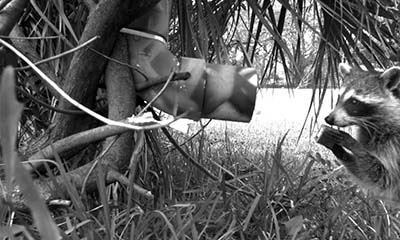July 26, 2016

APHIS’ Wildlife Services and cooperators will begin distributing oral rabies vaccine baits by aircraft and by vehicle beginning on or about Aug. 8, 2016. The baits are distributed across rural areas by airplane and in suburban or urban areas by helicopter or vehicle. The baits will be distributed in the following select areas and time periods:
In Northeast to Mid-Atlantic states, between August 8 and early-September:
-The Plattsburgh, N.Y. project will cover parts of northern New York and Maine, and distribute 306,000 baits by airplane and 720 by vehicle;
-The Allegheny, Pa. project will cover parts of Pennsylvania and distribute 302,040 baits by vehicle;

A racoon takes the bait. USDA APHIS distributes the rabies vaccine bait to wildlife in an attempt to stop the spread to humans. (Photo: USDA)
-The North Lima, Ohio project will cover parts of Ohio, Pennsylvania, and West Virginia and distribute 1,071,600 baits by airplane and helicopter and 3,240 baits by vehicle;
-The Clarksburg, W. Va. project will cover parts of West Virginia and Ohio and distribute 1,278,000 baits by airplane and 10,080 baits by vehicle.
In Massachusetts during September and early October:
-The Cape Cod, Mass. project will cover parts of peninsular Massachusetts and distribute 111,540 baits by bait stations and by vehicle.
In southern states, between late September and mid-October:
-The Abingdon, Va. project will cover parts of Tennessee, North Carolina and Virginia and distribute 940,500 baits by airplane and helicopter, and 10,080 baits by vehicle;
-The Dalton, Ga. project will cover parts of Alabama, Georgia, North Carolina and Tennessee and distribute 1,863,000 baits by airplane and helicopter, and 7,560 baits by vehicle.
The National Rabies Management Program was established in 1998 in recognition that the primary human risk of rabies is now due to exposure from wildlife rather than domestic pets. The goal of the program is to prevent the further spread of wildlife rabies and eventually eliminate terrestrial rabies in the United States through an integrated program that includes vaccinating wildlife against the disease.
RABORAL V-RG oral rabies vaccine baits are coated with a fishmeal attractant and may be packaged in one-inch square cubes or two-inch plastic sachets. The vaccine has been shown to be safe in more than 60 different species of animals, including domestic dogs and cats. Humans and pets cannot get rabies from contact with the baits, but are asked to leave them undisturbed if they encounter them. Dogs that consume large numbers of baits may experience an upset stomach, but no long-term health risks. If contact with baits occurs, immediately rinse the contact area with warm water and soap.
Rabies is caused by a virus that infects the central nervous system in mammals. Signs suggestive of rabies include unusual, aggressive or calm and “friendly” behavior, an inability to eat or drink, balance problems, circling, seizures, coma and finally death. While rabies is fatal once symptoms occur, human exposures can be successfully treated if post-exposure follow up is sought immediately following a bite.
Since 1995, Wildlife Services National Rabies Management Program has been working cooperatively with local, state and federal governments, universities and other partners to address this public health problem by distributing oral rabies vaccination baits in targeted areas. This cooperative program targets the raccoon variant in the eastern United States, and unique variants of rabies in coyotes and foxes in Texas.
For additional information on the raccoon oral rabies vaccine program, visit the APHIS website or call 1-866-4-USDA-WS (1-866-487-3297).
Source: USDA APHIS
You May Also Like




